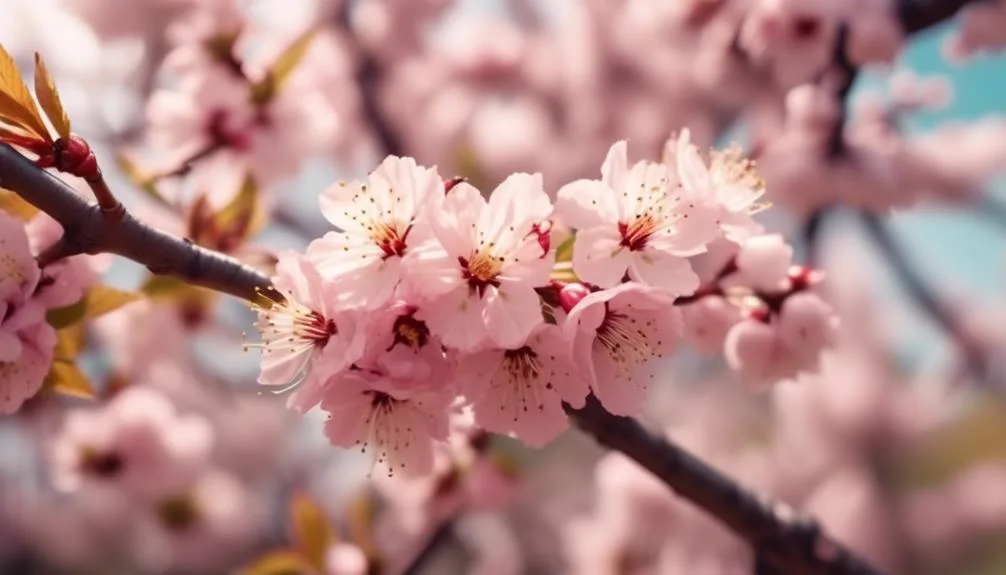Cherry trees do more than just look pretty. They help improve air quality and support local wildlife, playing a vital role in the ecosystem.
Exploring the ways cherry trees benefit the environment reveals their significant impact.
Air Quality Improvement
By planting cherry trees in your local area, you can actively contribute to improving air quality and creating a healthier ecosystem for everyone.
Cherry trees are renowned for their exceptional oxygen production. During photosynthesis, they absorb carbon dioxide and release oxygen, thereby increasing the amount of oxygen in the air. This process helps in reducing pollution and improving air quality.
Additionally, cherry trees act as natural air filters, trapping harmful pollutants on their leaves and bark, thus aiding in pollution reduction. The presence of these trees in urban areas can mitigate the adverse effects of air pollution, creating a more breathable environment for both humans and wildlife.
Biodiversity Support
With cherry trees already aiding in air quality improvement through their oxygen production and pollution reduction, they also play a crucial role in supporting local biodiversity. Cherry trees provide a diverse and abundant wildlife habitat, offering food and shelter for various species. The blossoms, nectar, and fruits attract pollinators such as bees and butterflies, contributing to the overall health of the ecosystem.
Additionally, the dense foliage of cherry trees provides nesting sites for birds and shelter for small mammals. By supporting a rich and varied ecosystem, cherry trees indirectly contribute to species preservation. The presence of diverse plant and animal life around cherry trees helps maintain ecological balance and resilience.
Therefore, the preservation and planting of cherry trees are vital for the continued support of local biodiversity and the overall health of the ecosystem.
Soil Health Enhancement
You can easily observe the positive impact of cherry trees on soil health, as their fallen leaves and fruits enrich the soil with organic matter, promoting nutrient cycling and fostering a fertile environment for beneficial microorganisms.
This natural process of soil nutrient enrichment benefits the entire ecosystem in several ways:
- Increased Soil Fertility: Cherry tree debris decomposes, releasing essential nutrients into the soil, enhancing its fertility.
- Improved Water Retention: The organic matter from cherry trees helps soil retain moisture, especially in dry periods, supporting overall plant health.
- Enhanced Microbial Activity: Beneficial microorganisms thrive in the enriched soil, contributing to nutrient availability for plants.
- Erosion Prevention: The improved soil structure reduces erosion potential, preserving the integrity of the local ecosystem.
Cherry trees play a vital role in maintaining healthy, productive soils, ultimately supporting diverse flora and fauna.
Pollinator Attraction
Attracting pollinators to your local ecosystem, cherry trees provide a vital source of nectar and pollen, supporting the reproduction and diversity of plant species.
The flower abundance of cherry trees acts as a magnet for a wide array of insects, thereby enhancing insect diversity in the area.
This diverse insect population contributes to the overall health of the ecosystem by aiding in the pollination of various plant species, not just cherry trees.
As pollinators visit cherry blossoms to collect nectar and pollen, they inadvertently transfer pollen from one flower to another, facilitating the fertilization process and the production of fruits and seeds.
This process is crucial for the survival of many plant species, making cherry trees valuable contributors to the local ecosystem's ecological balance and sustainability.
Cultural and Aesthetic Value
The allure of cherry blossoms extends beyond their role in pollinator attraction, as they hold significant cultural and aesthetic value in various societies, symbolizing beauty, renewal, and the ephemeral nature of life. The cultural significance and natural beauty of cherry trees are evident in the following ways:
- Traditional Festivals: Cherry blossoms are celebrated in various cultures through festivals like Hanami in Japan, where people gather to appreciate the transient beauty of the blossoms.
- Art and Literature: Cherry blossoms have inspired countless artists and writers, symbolizing the fleeting nature of life and the beauty in impermanence.
- Landscaping and Gardens: Cherry trees are often planted in gardens and parks for their picturesque blooms, enhancing the visual appeal of these spaces.
- Symbol of Hope: In some cultures, cherry blossoms represent new beginnings, hope, and the cycle of life, adding a deeper layer of cultural significance to their beauty.
Conclusion
With their ability to improve air quality, support biodiversity, enhance soil health, attract pollinators, and add cultural and aesthetic value, cherry trees are indispensable to local ecosystems.
Their impact on both humans and wildlife underscores their significance in maintaining a healthy environment.
Take a moment to ponder the profound contributions of cherry trees to your community, and consider the interconnectedness of all living beings in our ecosystem.
Mark Hoffman is a dedicated arborist and tree care specialist with over a decade of experience. His love for trees began when he visited Yosemite National Park as a teenager and was awestruck by the giant sequoias. Mark pursued his passion by studying forestry at Michigan Technological University, where he earned a Bachelor of Science degree.
Since then, he has worked tirelessly in the field of arboriculture, helping to preserve and protect trees in his community. His expertise and dedication have made him a respected leader in the industry and a valuable resource for anyone seeking advice on tree care.
